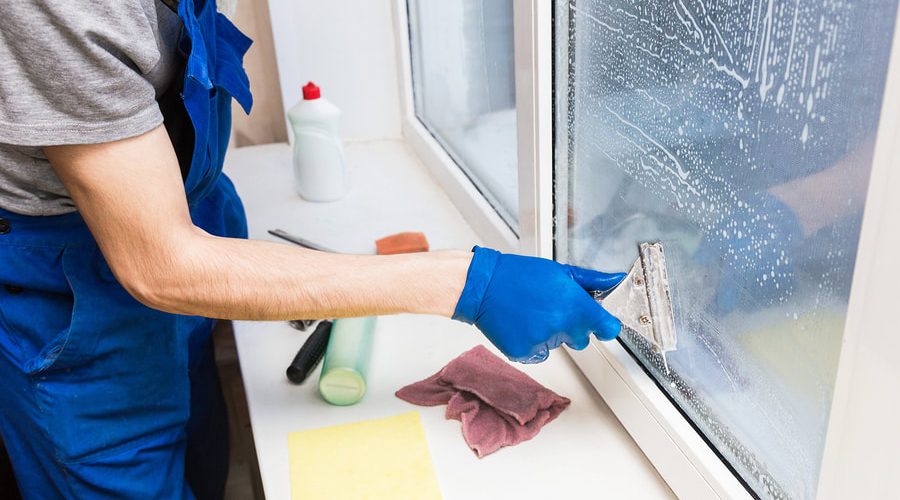Window cleaning is a simple task that most people can do themselves. However, there is a science behind window cleaning that can help you get the best results.
The first step in window cleaning is to remove any loose debris, such as leaves, twigs, or trash. This will help the cleaning solution to work more effectively.
The next step is to apply a cleaning solution to the window. There are many different types of cleaning solutions available, so you can choose one that is appropriate for the type of window you are cleaning.
Once the cleaning solution has been applied, you can use a squeegee to remove the dirt and grime from the window. Be sure to work from top to bottom to prevent dirty water from dripping onto areas that you have already cleaned.
Finally, you can rinse the window with clean water to remove any soap or detergent residue.
Here are some additional tips for window cleaning:
Use a soft cloth or sponge to clean the window. Harsh materials can scratch the glass.
Be careful not to apply too much pressure when cleaning the window. This can also scratch the glass.
If you are cleaning a window that is exposed to direct sunlight, be sure to work quickly so that the cleaning solution does not dry before you have a chance to rinse it off.
By following these tips, you can get your windows sparkling clean with little effort.
Here is a more detailed look at the science behind window cleaning:
The dirt and grime that builds up on windows is made up of a variety of materials, including dust, pollen, and bird droppings. These materials can be difficult to remove, especially if they have been allowed to build up for a long time.
The cleaning solution that you use helps to break down these materials and make them easier to remove. The type of cleaning solution that you use will depend on the type of window you are cleaning. For example, you will need to use a different cleaning solution for a glass window than you would for a vinyl window.
The squeegee is used to remove the dirt and grime from the window. The squeegee works by using a thin film of water to carry the dirt and grime away from the window.
Rinsing the window with clean water helps to remove any soap or detergent residue that may be left behind. Soap and detergent residue can leave a film on the window that can make it look cloudy or streaky.
By understanding the science behind window cleaning, you can get the best results and keep your windows looking their best.
Getting streak-free windows is a challenge that many people face. It seems like no matter how hard you try, there’s always a smudge or streak somewhere. But there is a science behind getting streak-free windows, and by following a few simple tips, you can get your windows looking their best.
The first step is to choose the right cleaning solution. There are many different types of window cleaning solutions available, so it’s important to choose one that is appropriate for the type of windows you have. For example, if you have vinyl windows, you’ll need to use a cleaning solution that is specifically designed for vinyl.
Once you have your cleaning solution, it’s time to start cleaning. Start by spraying the solution on the window, and then use a squeegee to remove the dirt and grime. Be sure to work from top to bottom to prevent dirty water from dripping onto areas that you have already cleaned.
The key to getting streak-free windows is to rinse them thoroughly. After you have used the squeegee, rinse the window with clean water to remove any soap or detergent residue. You can also use a microfiber cloth to wipe away any remaining streaks.
Here are a few additional tips for getting streak-free windows:
- Use a soft cloth or sponge to clean your windows. Harsh materials can scratch the glass.
- Be careful not to apply too much pressure when cleaning your windows. This can also scratch the glass.
- If you are cleaning windows in direct sunlight, be sure to work quickly so that the cleaning solution does not dry before you have a chance to rinse it off.
By following these tips, you can get your windows sparkling clean and streak-free.
Here are some additional details about the science behind streak-free windows:
- Streaking is caused by the presence of soap or detergent residue on the window. These residues can form a film on the glass that can make it look cloudy or streaky.
- The key to preventing streaking is to rinse your windows thoroughly with clean water after you have applied the cleaning solution. This will help to remove any soap or detergent residue that may be left behind.
- You can also help to prevent streaking by using a squeegee that has a good blade. A good blade will help to remove the dirt and grime from the window without leaving any streaks.
Physics and Chemistry Work Together to Clean Your Windows
When you clean your windows, you are using the principles of physics and chemistry to remove dirt, grime, and other debris.
Physics
Physics plays a role in window cleaning by helping to remove dirt and grime from the surface of the glass. The cleaning solution that you use helps to break down the dirt and grime, making it easier to remove. The squeegee that you use helps to remove the dirt and grime from the glass by using a thin film of water to carry it away.
Chemistry
Chemistry also plays a role in window cleaning by helping to prevent streaks. Streaks are caused by the presence of soap or detergent residue on the glass. These residues can form a film on the glass that can make it look cloudy or streaky. By rinsing your windows thoroughly with clean water after you have applied the cleaning solution, you can help to remove any soap or detergent residue that may be left behind.
Here are some additional details about how physics and chemistry work together to clean your windows:
- The cleaning solution
The cleaning solution that you use helps to break down the dirt and grime on the surface of the glass. The solution does this by using surfactants, which are molecules that have both hydrophilic (water-loving) and hydrophobic (water-repelling) ends. The hydrophilic ends of the surfactants attach to the dirt and grime, while the hydrophobic ends attach to the water. This helps to loosen the dirt and grime from the surface of the glass.
- The squeegee
The squeegee helps to remove the dirt and grime from the surface of the glass by using a thin film of water to carry it away. The squeegee blade should be at a 45-degree angle to the glass surface for best results.
- Rinsing with clean water
Rinsing your windows thoroughly with clean water after you have applied the cleaning solution helps to remove any soap or detergent residue that may be left behind. Soap and detergent residue can form a film on the glass that can make it look cloudy or streaky.
By understanding how physics and chemistry work together to clean your windows, you can get the best results and keep your windows looking their best.
There are many different ways to clean windows, each with its own advantages and disadvantages. The best method for you will depend on your individual needs and preferences.
Traditional window cleaning is the most common method. It involves using a bucket, sponge, and cleaning solution. This method is relatively inexpensive and easy to do, but it can be time-consuming and difficult to get streak-free results.
Pressure washing is a more efficient way to clean windows. It uses a high-pressure stream of water to remove dirt, grime, and other debris. This method is quick and easy, but it can be dangerous if not done properly.
Robotic window cleaning is a new and innovative way to clean windows. It uses a robotic device to clean windows automatically. This method is hands-off and efficient, but it can be expensive.

Here is a more detailed look at the pros and cons of each method:
Traditional window cleaning
Pros:
- Inexpensive
- Easy to do
- Can be used on any type of window
Cons:
- Time-consuming
- Difficult to get streak-free results
- Can be dangerous if not done properly
Pressure washing
Pros:
- Quick and easy
- Effective at removing dirt, grime, and other debris
- Can be used on any type of window
Cons:
- Dangerous if not done properly
- Can damage windows if not used correctly
- Can be noisy
Robotic window cleaning
Pros:
- Hands-off
- Efficient
- Can be used on any type of window
Cons:
- Expensive
- Can be difficult to set up and use
- May not be as effective as traditional window cleaning
Ultimately, the best way to clean your windows is the method that works best for you. If you are looking for an inexpensive and easy way to clean your windows, traditional window cleaning is a good option. If you are looking for a quick and efficient way to clean your windows, pressure washing or robotic window cleaning may be a better
Ben & Dan Cleaning: Your Window Cleaning Experts
https://benanddancleaning.ae/ are two longtime friends with years of experience in the window cleaning industry. They use state-of-the-art equipment and quality cleaning products to get your windows clean quickly and thoroughly.
Benefits of Ben & Dan’s services:
Use of state-of-the-art equipment and quality cleaning products
Fast and thorough cleaning of your windows
Competitive prices



